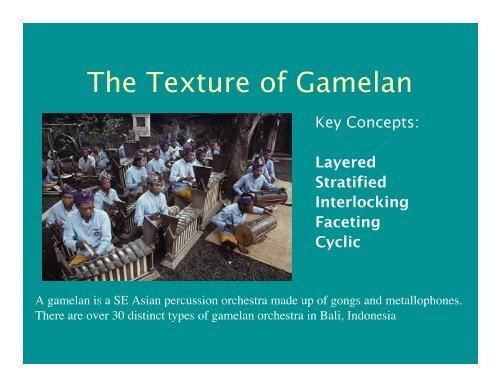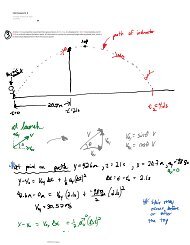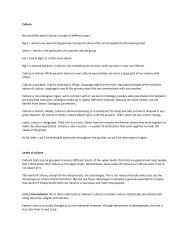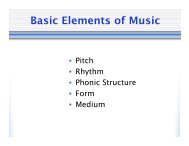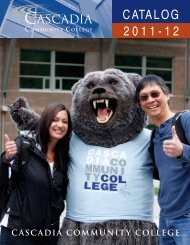Balinese Gamelan.pdf
Balinese Gamelan.pdf
Balinese Gamelan.pdf
Create successful ePaper yourself
Turn your PDF publications into a flip-book with our unique Google optimized e-Paper software.
The Texture of <strong>Gamelan</strong><br />
Key Concepts:<br />
Layered<br />
Stratified<br />
Interlocking<br />
Faceting<br />
Cyclic<br />
A gamelan is a SE Asian percussion orchestra made up of gongs and metallophones.<br />
There are over 30 distinct types of gamelan orchestra in Bali, Indonesia
Instrumental Layers<br />
• Gongs<br />
• Metallophones<br />
• Gong chimes<br />
• Other melody instruments<br />
• Drums and cymbals
<strong>Gamelan</strong> Gong Kebyar<br />
A type of gamelan developed in the 1920s, now<br />
the most popular form of gamelan in Bali
Gongs<br />
• Made of bronze<br />
• Gongs provide a metric<br />
framework called a gong<br />
cycle<br />
• 4 gongs: gong, kempur,<br />
klentong, kempli<br />
• A gong cycle is a<br />
repeating sequence of<br />
gongs
<strong>Balinese</strong> Gong Cycles<br />
• Metric framework or rhythmic<br />
mode<br />
•Cycles consist of multiples<br />
of 4 (8, 16, 32….128)<br />
• Kempli plays the basic pulse<br />
• Kempur and klentong<br />
punctuate certain beats<br />
• Large gong plays on the final pulse<br />
marking the end of the cycle<br />
• Melodies are composed to fit into a<br />
cycle
Keyed Instruments<br />
Metallophones<br />
• Idiophones that provide melodic content<br />
• Metal keys hit with a wooden hammer or rubber mallet<br />
• Tuned in pairs (ngubang -ngisep) to get a distinctive “wavering”<br />
timbre<br />
• Low register (one octave range, plays basic melody)<br />
• High register gangsas (two octave range, play interlocking<br />
elaborations of the melody)
Gong chimes<br />
• Bronze kettles arranged horizontally from low<br />
to high pitch (the larger the gong, the lower<br />
the pitch)<br />
• Reyong: 12 kettles played by 4 musicians<br />
• Gong chimes provide rhythmic accents and<br />
melodic ornamentation by interlocking
Other Melodic Instruments<br />
• Suling is a bamboo<br />
flute<br />
• Rebab is a 2-stringed<br />
fiddle played with a<br />
bow<br />
• Play heterophonic<br />
versions of the melody
Drums and Cymbals<br />
• Two double-headed barrel<br />
drums (kendang) lead the<br />
ensemble<br />
• Like gangsas, they play<br />
composite patterns<br />
• Cymbals (ceng-ceng)<br />
reinforce rhythmic<br />
patterns
Building the Layers<br />
“Stratified Heterophony”<br />
Ornamented Melody Plays complete melody<br />
(heterophony)<br />
Interlocking rhythmic<br />
patterns<br />
Kotekan (Interlocking<br />
ornaments)<br />
Adds rhythmic intensity,<br />
Plays leadership role<br />
Faceting to create high<br />
density texture/high register<br />
Pokok (Basic Melody) Low register, low density<br />
Gong Cycles Basic metric framework,<br />
low density, low register
Building Melodies<br />
Scales are derived from a 7-tone “parent” scale, known as pelog<br />
A <strong>Balinese</strong> scale can be thought<br />
of as a certain pattern of intervals:<br />
Small-small-large-small-large<br />
These intervals are given names:<br />
Nding-ndong-ndeng-ndung-ndang<br />
Some gamelan can play multiple scales,<br />
while others are limited to only one<br />
<strong>Gamelan</strong> gong kebyar is usually<br />
tuned to selisir
Composing and Performance<br />
• Compositions are not written down, but passed from player to player<br />
through group rehearsals (complete with kotekan, rhythmic patterns,<br />
etc) = Oral/Aural Transmission<br />
• Many newer <strong>Balinese</strong> compositions have known composers, but pre-<br />
20th C. pieces do not<br />
• Improvisation or variation of the composed piece does not take place,<br />
except in two senses:<br />
– Prior to performance:<br />
• An ensemble may make changes (by adding new kotekan, for example) to an<br />
older piece for variety or to make it “theirs”<br />
– During performance:<br />
• Suling and rebab players ornament the melody according to the limits of their<br />
instrument (the result is heterophony)<br />
• Drummers may add ornaments according to their ability
What is Kotekan?<br />
• Interlocking figuration played on a pair of<br />
gangsas, forming a composite melody<br />
• Consists of 2 complementary parts:<br />
Polos/Sangsih: these are the two interlocking<br />
rhythmic/melodic patterns that combine to create kotekan<br />
Faster!<br />
Kotekan norot<br />
“following”<br />
Kotekan nyog-cag<br />
“leaping”<br />
Kotekan telu<br />
“three”<br />
Full!


